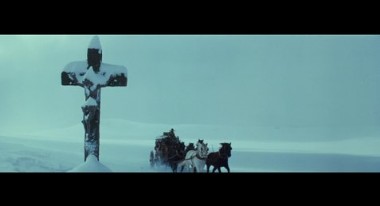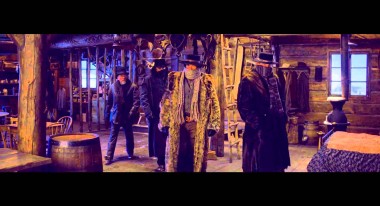 Back to selection
Back to selection
True Crit
Weekly film reviews. by Howard Feinstein
Staggered: The Hateful Eight
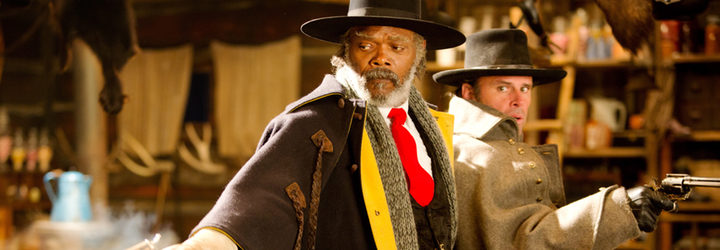 Samuel L. Jackson, Walton
Goggins in The Hateful Eight
Samuel L. Jackson, Walton
Goggins in The Hateful Eight The following review contains spoilers.
In Quentin Tarantino’s superbly balanced ensemble piece, The Hateful Eight, the passengers and drivers we meet at the start of the picture, dropped off at Minnie’s Haberdashy, a spacious Wyoming way station, by two different stagecoaches on different but overlapping missions, all have masked identities. Six years after the end of the Civil War, these are some of battle’s renegade residue, Confederate vets with few prospects who depend on bounty hunting to survive in a particularly testy postwar America.
In the second coach there’s Chris Mannix (Walton Goggins, displaying the best of his high-energy talent), who claims to be the newly appointed sheriff of Red Rock, the coach’s eventual destination. John Ruth (blustery Kurt Russell) doesn’t self-identify as the town’s hangman, but he carries the title.
Ruth is preoccupied, connected as he is by handcuffs to burnt-out Daisy Domergue (Jennifer Jason Leigh), who’s got a huge shiner and is the sole female in the odd pack. For the loot, he plans to deliver her to be hanged for murder. More than likely, Daisy is a prostitute. She also belongs to a gang of outlaws led by her brother, Jody (Channing Tatum, so clean-cut that he looks as if he just got out of Hebrew school, and so horribly miscast you can only assume someone wanted to add a bigger star to a machine that was not broken). We don’t meet him until halfway through the film, and soon intuit a probable history of incest between the siblings.
The last of the group on that stagecoach is Major Marquis Warren (Samuel L. Jackson, outstanding), a black man and former Union soldier, who is in the unenviable position of singly countering the racism so openly professed by the others. He is also the most widely known bounty hunter around, as well as a quick study who sums up the state of things in difficult moments with the cunning of a Sherlock Holmes or a Miss Marple. He does have a less than stellar track record as far as murdering Indians goes, and has callously burned down a building full of white men, but his unique resume and charismatic bearing have elevated him into the role of outspoken advocate for the rights of emancipated slaves, not to mention the focal character of the film.
The other principal participants: General Sanford “Sandy” Smithers (Bruce Dern), a slightly senile higher-up in the military wing of the Confederacy; Oswaldo Mobray (Tim Roth), a British adventurer who incorrectly identifies himself as Red Rock’s hangman; Joe Gage (Michael Madsen), a Confederate cowpuncher who becomes pivotal in a subversive plot; and Senor Bob (Demian Bichir, one of the few actors here who actually underplays), the Mexican caretaker of the store.
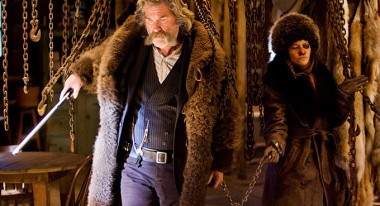
Women get a rap somewhere between insignificant and despicable. John Ruth slugs and otherwise abuses Daisy, both physically and psychologically. If she had ever been an object of desire for men, the attraction has dissipated. In fact, the strongest bonding between men who had been in opposite camps occurs in spite of Daisy. She is not constructed as a lovable victim. She is vulgar and probably the most mercilessly prejudiced of the entire crew. No one uses the word nigger more than she, and with a caustic tone. But even in the cases of the more attractive Minnie and her female staff, little respect is accorded them during the brief period they occupy the screen and flirt with the visiting males.
None of these characters can simply be labeled good or bad, at least for the first half of the movie. The director told Deadline.com’s Mike Fleming last year that the film has “no heroes, no Michael Landons. Just a bunch of nefarious guys in a room, all telling backstories that may or may not be true. Trap those guys together in a room with a blizzard outside, give them guns, and see what happens.”
In his first full western, Tarantino is much less indebted to, say, spaghetti westerns (even though his composer is Ennio Morricone) than to primetime American TV of the ‘60s and ‘70s, series like The Virginian, High Chaparral, and Bonanza, which every season had some episodes in which outlaws would take the lead characters hostage. Revelations about their sordid pasts would frequently come to light in the latter part of the shows.
A top-down effect takes place in The Hateful Eight. The characters follow Tarantino’s example and mislead the spectator: the better to surprise him or her with bloody spurts of violence, and to make believable a narrative structure that is more staggered than chronological. Disruption marks the movie from the get-go, including the director’s manipulation of time.
The film opens with horses gracefully pulling one of the stagecoaches along a mountain path that pierces wide sheets of snow. A towering cross dominates the winter landscape. Shot in seductive 70mm with the same Panavision anamorphic lenses used in the 1959 Ben-Hur, this setting, the official prologue to the film, spectacularly reeks of purity. The road, however, leads to nasty ends, to the basest instincts of the human animal.
The narrative is divided into chapters. Changing the order effectively allows it to be smoothly convoluted rather than roughly jagged. Repetition of scenes, or portions of them, maintains comprehension amidst increased discontinuity, whether it be visual or aural, such as snatches of conversation we have already heard but from another vantage point.
In a surreal touch, the reading of a letter supposedly written by Lincoln to his friend, the Major, brackets the film, sandwiching the irregular time periods and locales inside a grave inspirational format. It gives credence to new alliances between anti- and pro-slavery proponents. The Hateful Eight is packed with contradictions. It is essentially dystopian, yet the structural set-up — whether Lincoln’s missive is authentic or not doesn’t matter, although odds are on The Major himself as author — offers perhaps a glimmer of hope. Late in the film, the inimitable Roy Orbison sings the C & W antiwar song, “There Won’t Be Many Coming Home,” following a BFF scene between The Major and Mannix, formerly committed enemies. Each of these macho fellows pays homage to a stanza that he says chokes him up whenever he hears it. It does the same to me.
And before you kill another
Listen to what I say
If they all come back but one
He was still some mother’s son
The 70mm equipment also leads to confused spatial expectations. Already the long scenes in the second stagecoach are claustrophobic. (The first coach made its run before the blizzard began. We see it in flashback, even though, as you will see, in the film itself it takes its course after the one that went later, while it is snowing–it’s the reverse of what we would logically expect, except that Tarantino is not logical.) There is little relief. Once its passengers are inside Minnie’s, they stay put. Of course, the blizzard is the actual excuse for confinement, but Tarantino wants to squeeze loaded conversations and actions together until something explosive becomes the default way to discharge so much pent-up energy. For one thing, bounty hunters tend to work alone; for another, they are accustomed to an outdoors that in this instance is not available.
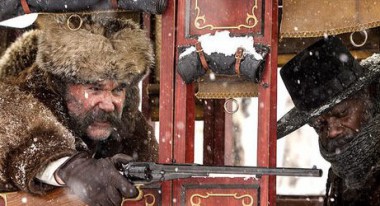
Tarantino’s regular DP Robert Richardson shoots the high ceilings of Minnie’s from low angles to stress that indoor pressure. Releasing it is a quick and dangerous process. To begin with, people run out of patience. The rapidity with which some likable minor characters are dispatched is shocking. The mood is as hyper as the filmmaker: Horrible acts are dispensed so fast that they are hard to keep up with. The film is a variety show of grotesquerie: brains blown out, indoor hangings, limbs severed, blood matted, and vomiting galore, especially in the direction of others.
Given the precise, complex construction of this particular narrative, it is not surprising that flashbacks and verbal recall seem a natural, integral part of this picture, relying as it does on stream of consciousness. The sequence that visualizes The Major’s blow-by-blow of how he humiliated the General’s naked son is fated to become a classic: For a blanket in freezing cold weather, he fellates exhaustively this black man whose race he disparages. The Major and Mannix confide in each other, recounting episodes from their childhoods. The most salient theme running through these confessionals? Revenge. Hmmm, ya’ think maybe provocation too?
